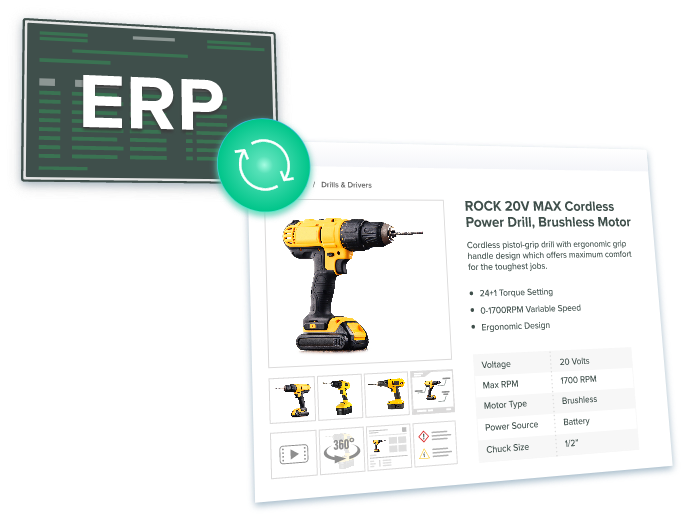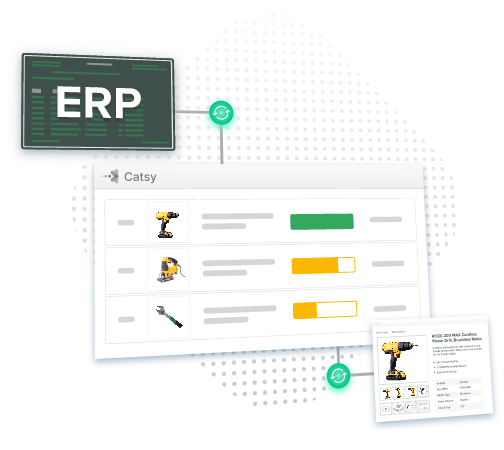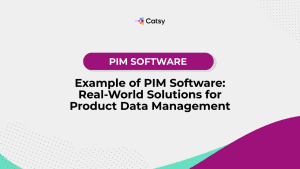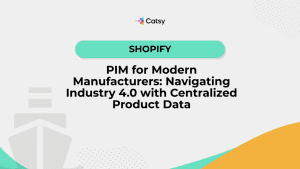How ERP, PIM and DAM Work Together to Form a Single Source of Truth

- A single source of truth is an essential tool for revenue generation
- Though vital, ERP (Enterprise Resource Planning) alone is not a single source of truth
- PIM and DAM fill the void by uniting with ERP to create a single source of truth
In this Article
Many circumstances factor into the success of a business. One important aspect is the technology upon which businesses operate. For many, those systems include ERP, PIM, and DAM. In order for this technology to work, the first thing a business needs is to create a system of record for various aspects of operations.
A system of record is basically the central way to organize data and information as it pertains to customers, products, vendors, accounting, logistics, inventory etc.
Depending on the size of the organization, it is either a single system or a set of systems that form the nucleus of such data and business processes around it.
In most organizations, no system is more central to this than an ERP system. ERP, which stands for Enterprise Resource Planning offers a wide swath of functionality but one area it is not particularly adept at is marketing content, product content, and digital asset management.
Most ERP systems are incapable of handling many aspects of the business. In this blog post, we deep dive into the various types of business content and the system best suited to handle it.

What is ERP?
ERP or Enterprise Resource Planning is a way to integrate main business processes with the assistance of software and technology. According to an article by Computer World, the Gartner Group (a Connecticut-based IT consulting firm) coined the term in the 1990s.
The ERP can be locally based-or cloud-based. Cloud-based applications have grown due to information readily available from any location with internet access. This is especially useful in a post-covid environment, with many teams working hybrid or fully-remote schedules.
ERP provides an integrated and continuously updated view of core business processes using common databases maintained by a database management system. In addition, ERP systems track business resources—cash, raw materials, production capacity—and the status of business commitments: orders, purchase orders, and payroll.
The applications that make up the system share data across various departments (manufacturing, purchasing, sales, accounting, etc.) that provide the data. In addition, ERP facilitates information flow between all business functions and manages connections to outside stakeholders.
Historical Context of ERP
Enterprise system software is a multibillion-dollar industry that produces components supporting various business functions. Though early ERP systems focused on large enterprises, smaller enterprises increasingly use ERP systems.
The ERP system integrates varied organizational systems and facilitates error-free transactions and production, enhancing the organization’s efficiency. However, developing an ERP system differs from traditional system development. For example, ERP systems run on various computer hardware and network configurations, typically using a database as an information repository.
The best PIM software aims to store and manage content for all product marketing needs. Danich and Gannon define it as a system that “can be used to enrich products for commercial purposes across three dimensions: content, commercial, and communal.” In other words, PIM’s purpose is to inform and delight customers and make work easier for your organization’s employees.
A product information management solution holds and organizes all levels of product categorization and the outputs – or the distribution channels.
- Products
- Variants
- Possible Domains of Attributes
- Channels
Products
As per the name, PIM stores all the information describing the item an organization is selling. Natural product data like SKUs, taxonomy, price, materials, terms, and so on are input from other sources, like an ERP. Moreover, storing it all on PIM is to prepare it for marketing – transforming the data into compelling content.
Variants
Within each product category are variants. Variants, for example, establish the options of a single product type, like colors, sizes, or dimensions. For example, an armchair might have three variants of different colors, beige, black, and grey. All of these variants will appear on a single product page. Amazon, for example, calls this variant relationship parent-child.
Possible domains of attributes
An attribute domain is a set of values allowed in an attribute. In other words, it’s all of the characteristic options under a category of the product attribute. So, a product domain helps categorize a group of related items and services under identifiable keywords or umbrellas. Of course, the language used for attribute domains depends on the organization.
Moreover, PIM classified all domains or categories of product attributes into a hierarchical structure.
This product hierarchy is what forms item relationships before you even publish. Thus, making it easy for both users and customers to find items.
The hierarchy starts with the broadest category before branching out into more specific categories. For example, it begins with a product need (the purpose of the products). Then product family (home or furniture), product class, line, type, brand, and finally, items.
In addition, on the customer’s end, product hierarchy makes the product searchable. Establishing this hierarchy from the PIM itself translates smoothly across all platforms you distribute your products.
Product Items
An item within a product line is part of a category of related articles. For example, a product line of showers may include the following items: body wash, body scrub, and shampoo. PIM makes merchandising for your online store easier and upselling and cross-selling and upselling. You’ll see items displayed in a “Customers also bought these products” section on a product page.
Channels
The other objective of PIM is to send out all product attributes to channels. Choose which channels you want to sell on (adding more as needed), and automatically publish all attributes straight from PIM. In addition, this makes it easier to manage multi-channel organizations, which have grown over the past years.
As a records system, PIM holds all the current and previous data across all these areas. For example, organizations in eCommerce need to keep track of their product data throughout their journey.
Historical Context of PIM
PIM, or product information management, is a system that came about to manage the large influx of data each organization will inevitably have.
In addition, one of the first resources that laid the foundation for building a PIM system was Building Database Driven Catalogs by Sherif Danish and Patrick Gannon. From this, we know that PIM emerged as a driver for digital catalogs – like specialized catalog management software. For example, in switching from print to digital a few decades ago, eCommerce companies needed a more innovative way of managing their internal product information.
Hence, creating a digital database that could hold all this necessary data. When it came to creating a catalog for retailers or customers, it would be as simple as using the database to extract data to populate a record.
Read Also: PIM System eCommerce

How ERP, PIM, and DAM Work Together
Now that we understand what a PIM and an ERP are, let’s discuss the primary differences. Furthermore, it should be noted that there are things that one software concept can do that the other is simply not designed to do, and vice versa. In addition, the primary differences or similarities between the two are as follows:
- Customer Information
- Vendor-Related Information
- Pricing-Related Data
- Product Attribute
- Product Taxonomy
- Digital Assets
Customer Information
| ERP | PIM | DAM | |
| Customer Record | X | ||
| Customer Groups | X | ||
An ERP system is a record system for a customer record, which it shares with a CRM. And a PIM does very little with individual customer records.
This article mentioned previously that one of the primary roles of an ERP is to centralize information related to production. Moreover, an essential part of this data is transactional data – including customer information.
For example, an ERP would house knowledge concerned with Customer Relationship Management CRM. CRM data typically centers around business functions: sales and marketing, commissions, services, customer contact, and call center support.
A portion of customer information is a customer record. This includes basic information like name, address, phone number, or email address, and it may also include an order history.
This information is helpful because it allows your employees to gain insight into the level of interaction that a particular customer has had with your company. Within the same vein, this information can also be used to provide valuable marketing assets and allows for marketing automation.
Individual customer information can then be used to form customer groups. This can be something as simple as customers in a specific state and can even be used to identify points of extrapolation for your customers further.
ERP can improve data security in a closed environment. A typical control system, such as the kind offered by ERP systems, allows organizations to ensure critical company data is not compromised more easily.
This changes, however, with a more open environment, requiring further scrutiny of ERP security features and internal company policies regarding security.
 Vendor-Related Information
Vendor-Related Information
| ERP | PIM | DAM | |
| Stock, Pricing, and Ordering | X | ||
| Product descriptions, specifications | X | ||
| Item Setup information | X | ||
| Images provided by vendor | X |
An ERP system is a record system for a customer record, which it shares with a CRM. So, PIM does very little with individual sales information.
This can include information related to supply chain management like supplier scheduling, inventory, claim processing, and warehousing information.
Vendor-related information is housed within an ERP that includes stock, pricing, and ordering information. Moreover, this kind of information is critical to a company’s supply chain.
Having a system that allows for easy access to this information can save time, increase revenue, and improve an organization’s overall workflow.
Stock can include details on how many of a specific product or part are on hand or will be on hand in your organization.
In addition, pricing is information related to actual product manufacturing cost and price per unit. It may also include MSRP and sale pricing.
Since an ERP does not do very much with sales information, product descriptions, and specifications are an example of information that would be stored in PIM software, as opposed to an ERP.
Product descriptions are a vital facet of product information, and it’s essential to have clear, consistent, and accurate descriptions of products. In addition to these descriptions, product specifications provide an additional layer of validation for customers in understanding if a product will be the right fit for what they are looking for.
Item Setup Information is the critical set of information related to identifying products contained within your organization.
Another tool that can be useful in marketing your products is a Digital Access Management or DAM tool. While these tools are often separate from a Product Information Management software, it is not found within an ERP system.
 Pricing-Related Data
Pricing-Related Data
| ERP | PIM | DAM | |
| Standard COST | X | X | |
| List Price, MSRP | X | X | |
| Customer Specific Pricing | X |
Pricing-related data is contained within individual product records found in an ERP and a PIM. This data is relevant to the missions of both systems – providing customer service and centralizing product information to ensure that it is accurate across marketplaces.
Standard Cost
Standard costs are estimates of the cost of goods sold and the cost required to produce your products. For example, they usually consist of direct materials, direct labor, and manufacturing overhead.
Direct materials refer to the materials used to create your product, such as the fabric a clothing company uses to generate its garments. Direct labor refers to employees’ work to produce the product. Manufacturing overhead includes indirect costs, such as the electricity required to power your facility.
Standard costs approximate actual costs, but they probably won’t be precisely the same. The difference between the typical and actual costs is known as variance. If it costs less to produce a product than the standard cost predicted, that’s a favorable variance. But if it costs more than the typical cost, that’s an unfavorable variance.
Standard costing often shows where variances come from. For example, if you use more cloth to make your clothing than you’d planned when creating your expected cost, that’s a materials quantity variance. If it takes your workers less time to complete the clothing than you’d thought, that’s a labor rate variance.
These concepts are found in both an ERP and PIM.
List Price and MSRP
List price and MSRP are prices that a manufacturer has determined as the price at which a particular product should be sold to have the best-case scenario for a profit. For example, according to the manufacturer, MSRP stands for Manufacturer’s Suggested Retail Price and is the optimal price for a product. The listed Price is the price that a product is being sold at, this price could be the same as MSRP, or it could be more or less than the MSRP.
These two concepts are also found in both ERP and PIM.
Customer Specific Pricing
Customer-specific pricing is a group of prices only available to a specific group of customers. These are often promotional prices and are found primarily in an ERP.
 Product Attributes
Product Attributes
| ERP | PIM | DAM | |
| Basic SKU Information, Statuses, Product Group Codes | X | X | |
| Product Dimensions, Weights, Specs | X | ||
| Product Characteristics | X | ||
| Product to Digital Asset Relationships | X | X |
Attributes are a way that data is attached to a product. These attributes can be any identifiable characteristic of a product, and they essentially make up the recipe of a product.
So, think of a recipe you like to make; what information is shown within the written recipe to make it happen? These are the questions that product attributes answer.
Product attributes can be any of the following:
- Basic SKU Information, Statuses, SKU Group Codes
- Dimensions, Weights, Specs
- Specific Characteristics
Another product attribute element found in both PIM and DAM systems is the product of digital asset relationships. These relationships are essential to maintain because they are a literal way to illustrate what kind of product a customer will receive.
 Product Taxonomy
Product Taxonomy
| ERP | PIM | DAM | |
| Category Hierarchy | X | ||
| Attribute Governance | X |
Product Taxonomy is how products are organized in an optimal way to appeal to your customer base. This typically includes a top-level with a generic main set, followed by more granular subcategories that apply to a specific product.
For example, a taxonomical structure is a critical element of a solid eCommerce marketing strategy and is found only in PIM software.
This approach consists of a category hierarchy, as mentioned above, and attribute governance. Moreover, attribute governance is the ability to limit specific attributes to a particular set of products based on category.
Product attributes allow for a way to illustrate aspects of a product that may not be able to be seen in a primarily eCommerce environment.
When only pictures of a product are available, attributes like material, dimension, or compatibility provide an additional layer of insight into what kind of product a customer will receive.
 Digital Assets
Digital Assets
| ERP | PIM | DAM | |
| Product Images | X | ||
| Spec Sheets | X |
Digital Assets are a way to visually display what type of product a customer should expect to receive from your company.
Research has demonstrated that it is for an emotional reason when purchasing a product. It goes beyond saying that users merely browse; they also wish to experience it.
So, this is where having the right images is vital. Detailed and quality images can engage your customers’ feelings, which is critical if you would like to increase sales.
By using 360-degree images and placing them on your listing, your customer can visualize pertinent details about your product that may be a dealbreaker.
So, visualizing the product from as many angles as possible helps the customers create an image in their heads of what they are getting and how they can identify with it.
Conclusion
In conclusion, ERP, PIM, and DAM systems have particular ways of fulfilling business needs. By utilizing the specific strengths of both methods, you can create processes that allow you to streamline your business’s workflows. Moreover, there are many advantages to both systems separately.
When combined with a DAM, they provide a full-scale solution to allow you to focus on improving your interactions with customers, along with internal processes.
Catsy simplifies the way brands manage and publish product content across online, retail and distribution channels. A cloud based PIM and DAM solution, brands operate out of a single source of truth to drive revenue using a three step strategy: normalize data, tailor for channels, speed products to market.
PIM is the short form for product information management. It is a set of principles and software used to create a single source of truth for product content, optimizing it for validity, accuracy, completeness, and grading to meet sales channels requirements.
Product data includes the information a product marketer needs to illustrate a product that appeals to the customer’s logic and emotions to achieve its end goal.
Product data elements include product names, descriptions, images, videos, product reviews, graphics, and designs.
Yes. Product data determines the level of satisfaction of your customers and prospective buyers. People prefer online stores that present product information in an easy-to-understand format and would go to where they can get that.
Accurate data can close the gaps between you and your competitors.
You can improve customer interactions by collecting data related to your brand’s key interaction points, such as their interests, values, demographics, preferences, online behaviors, shopping, and purchasing habits.
Analyzing these data and utilizing the results will help you personalize people’s experiences while interacting with your product page and organization.
You can improve customer interactions by collecting data related to your brand’s key interaction points, such as their interests, values, demographics, preferences, online behaviors, shopping, and purchasing habits.
Analyzing these data and utilizing the results will help you personalize people’s experiences while interacting with your product page and organization.
Yes. Catsy’s PIM solutions contain features that make it possible to achieve high-quality product data.
Our product categorization and catalog features organize your product information to help customers make informed purchases and keep prospective buyers glued to your product page.
Yes. Your products are a direct representation of your brand. When product information falls short due to low-quality product data, customers will become unsure of your brand and go for a better competitor.
Quality product data will help your brand stand out and stick to your customer’s memories, so finding you becomes more accessible next time.




